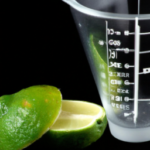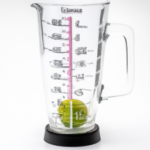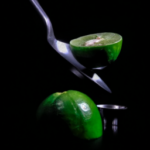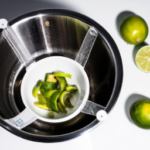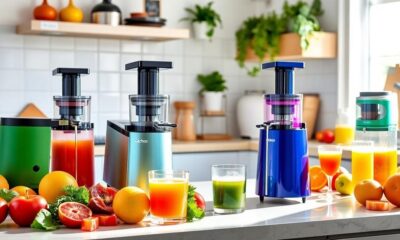Juice Tips and Tricks
How Much Juice In 1/2 Lime

Lime juice plays a crucial role in many recipes, from cocktails and dressings to marinades and sauces. As someone who loves to cook and try out new things in the kitchen, I often wonder how much juice can be squeezed from a single lime.
But not all limes are created equal – their size, age, and ripeness can all affect the amount of juice they yield. So, how much juice can you expect to get from half a lime?
Before we can answer that question, it’s important to understand the factors that can impact lime juice yield. By knowing what to look for when selecting limes and how to maximize juice extraction, you can ensure that you’re getting the most out of your citrus.
In this article, we’ll explore the science behind lime juice yield and share tips for measuring, maximizing, and substituting lime juice. Whether you’re a seasoned cook or just starting out, this guide will help you make the most of your limes and elevate your dishes to the next level.
Key Takeaways
- The amount of juice in half a lime is approximately 1 tablespoon, but can vary based on factors such as ripeness and juiciness.
- Accurate measurement of lime juice is crucial for achieving desired flavor and consistency in recipes.
- Rolling the lime on a hard surface and using a citrus juicer or reamer can help maximize juice yield.
- Fresh lime juice is a nutritious source of vitamin C and antioxidants, and incorporating it into one’s diet can be a penny-wise investment in health.
Factors that Affect Lime Juice Yield
When it comes to getting the most juice out of a lime, there are a few key factors to consider. Firstly, the ripeness of the lime can greatly affect the amount of juice you can extract. A ripe lime will generally yield more juice than an unripe one.
Additionally, the juiciness of the fruit itself and the method of juice extraction can also impact the final yield. By understanding these factors, you can optimize your lime juice yield and ensure you get the most out of your fruit.
Ripeness of the Lime
The lime’s ripeness affects the amount of juice you can extract from half of it. Ripeness measurement is one of the most important factors that determine the juice yield of a lime. As a lime ripens, it becomes softer and juicier, which means you can extract more juice from it. However, the acidity of the lime juice decreases as the fruit ripens.
Here are five important things to know about how the ripeness of a lime affects its juice yield:
- The juiciest limes are the ones that are plump, have smooth skin, and feel heavy for their size.
- Overripe limes that have started to turn yellow or have soft spots will yield less juice than a firm, green lime.
- If you’re using a lime that isn’t very juicy, try rolling it on a hard surface before cutting it in half. This can help break down the fibers and release more juice.
- Limes that are picked too early will be hard and dry and won’t yield much juice.
- The acidity of lime juice can affect the taste of your dishes. Ripe limes have lower acidity, which means they’re less sour than unripe limes.
Understanding how the ripeness of a lime affects its juice yield is important when cooking or making drinks that require lime juice. However, the juiciness of the fruit is also an important factor to consider, which we’ll explore in the next section.
Juiciness of the Fruit
You can feel the burst of freshness in every bite when you sink your teeth into a perfectly juicy lime. The juiciness of the fruit is one of the most important factors that determine its taste and usefulness in cooking.
In order to measure the juiciness of a lime, we can use a simple method: cut it in half and gently squeeze it over a measuring cup. The amount of juice that comes out can vary depending on the lime’s ripeness, but generally, a half lime can yield around 1-2 tablespoons of juice.
When it comes to taste preference, some people prefer a more tart and acidic flavor, while others prefer a sweeter taste. The juiciness of the lime can also affect its taste, as a juicier fruit can have a more diluted flavor compared to a drier one. This is why it’s important to choose the right lime for your recipe, depending on the taste you want to achieve.
Now that we know how to measure the juiciness of a lime, let’s move on to the next section and learn about the different methods of juice extraction.
Method of Juice Extraction
To extract the flavorful juice from a lime, it’s essential to choose the right method of extraction. There are two main methods: manual and electric.
Here are the pros and cons of each method for lime juice extraction:
-
Manual extraction: This method involves using a handheld citrus juicer or a fork to extract the juice. The advantages of manual extraction are that it’s inexpensive, requires no electricity, and gives you more control over the amount of pulp in the juice. However, manual extraction can be time-consuming and requires some physical effort.
-
Electric extraction: This method involves using an electric citrus juicer to extract the juice. The advantages of electric extraction are that it’s fast, easy, and requires less physical effort. However, electric juicers can be expensive, take up more space, and may not give you as much control over the amount of pulp in the juice.
Now that we’ve discussed the pros and cons of each method, let’s move on to a general guideline for lime juice yield.
General Guideline for Lime Juice Yield
Typically, squeezing a half of a lime will yield around 1 tablespoon of juice, but this can vary depending on the ripeness and size of the lime. When measuring lime juice for a recipe, it’s important to be as accurate as possible.
Using too little or too much juice can significantly alter the flavor and texture of the dish. To ensure the proper amount of juice is used, it may be helpful to use a citrus juicer or a small handheld reamer to extract the juice.
It’s also important to note that the temperature can affect the yield of juice, with warmer limes yielding more juice than colder ones. By following general guidelines and accurately measuring lime juice, the desired flavor and texture of a dish can be achieved.
This is crucial in achieving the perfect balance of flavors and ultimately, a successful dish.
Importance of Measuring Lime Juice
When it comes to cooking or making drinks with lime juice, measuring is crucial in achieving the desired flavor and consistency in recipes. As someone who’s experimented with different measurements, I’ve found that even a slight variation in the amount of lime juice can make a big difference in the final product.
Measuring also helps avoid waste by ensuring that you only use the necessary amount of limes for your recipe.
Achieving the Desired Flavor
Achieving the perfect flavor for your dish requires just the right amount of juice squeezed from half a lime. This is because lime juice can easily overpower other flavors in your dish if too much is added. On the other hand, if too little is added, the lime flavor may not be noticeable at all. Therefore, it’s important to measure the lime juice accurately to achieve proper flavor balance.
Recipe modifications may also be necessary to achieve the desired flavor. For instance, if you find that adding the juice from half a lime is still too much for your recipe, you can decrease the amount of lime juice by a few drops or adjust the other ingredients to balance out the flavor.
It’s important to remember that achieving the perfect flavor is a process of trial and error, and it may take a few adjustments to get it just right. With practice, you’ll learn to measure the lime juice accurately and make recipe modifications to achieve your desired flavor.
Moving on to the next section, consistency in recipes is also crucial in achieving a perfect dish.
Consistency in Recipes
To make sure your dish turns out consistently delicious, you’ll want to pay close attention to the measurements of each ingredient and how they’re prepared. Recipe consistency is key to achieving the desired flavor and texture every time you cook.
To achieve this, here are some tips to keep in mind:
-
Use measuring tools: Measuring spoons, cups, and scales are essential to ensure accuracy in your recipes. Eyeballing ingredients can lead to inconsistencies and ruin the final result.
-
Follow the recipe instructions: Every recipe is different, and following the instructions precisely can help you achieve the intended flavor and texture. Deviating from the recipe can lead to unwanted variations.
-
Keep track of changes: If you decide to make changes to the recipe, it’s important to document them. This can help you make adjustments in the future and maintain recipe consistency.
-
Practice makes perfect: Consistency comes with practice, so don’t be discouraged if your first few attempts don’t turn out as expected. Keep trying, and eventually, you’ll get the hang of it.
Maintaining recipe consistency and measuring accuracy not only ensures a delicious dish but also avoids waste. By following these tips, you’ll be able to create consistent recipes every time, minimizing the chances of throwing away ingredients and food.
Avoiding Waste
By avoiding unnecessary waste in the kitchen, I can save money and contribute to a more sustainable lifestyle. When it comes to using limes, there are several ways to avoid wasting them.
If I only need half a lime for a recipe, I can wrap the remaining half tightly in plastic wrap or store it in an airtight container in the refrigerator. Leftover lime can also be used in a variety of creative and delicious recipes, such as limeade, lime-infused water, or even in a marinade for meats.
One of my favorite ways to use leftover lime is to make a simple lime vinaigrette. I can mix the juice of a leftover lime with olive oil, honey, and a pinch of salt and pepper to make a tangy and flavorful dressing for salads or roasted vegetables. By finding ways to use all parts of the lime, I can minimize waste and make the most out of my ingredients.
Speaking of making the most out of ingredients, there are also tips and tricks for maximizing lime juice yield that can be useful in the kitchen.
Tips for Maximizing Lime Juice Yield
You’ll love these tricks for getting the most juice out of your limes! To maximize lime juice yield, here are some juice extraction techniques that I find helpful:
-
Roll the lime on a hard surface before cutting it. This helps break down the lime’s fibers, making it easier to extract the juice.
-
Cut the lime in half crosswise, not lengthwise. This exposes more of the pulp and makes it easier to squeeze.
-
Use a citrus juicer or reamer to extract the juice. This method is more efficient than squeezing the lime by hand.
-
Grate the lime zest before juicing it. The zest contains flavorful oils that can enhance the taste of the juice.
Using these techniques, you can extract the most juice from your limes and avoid wasting any of the fruit.
However, if you find that you still don’t have enough juice, there are alternative lime juice sources that you can explore.
Alternative Lime Juice Sources
If you’re running low on lime juice, consider other citrus fruits as a substitute. Lemons, oranges, and grapefruits are all great alternatives that can provide the same acidic flavor as lime juice.
Each fruit has its own unique benefits and drawbacks to consider when making your choice. Lemons, for example, have a slightly sweeter flavor profile than limes and are high in vitamin C. However, they can also be more tart and acidic, which may affect the overall taste of your dish.
Oranges, on the other hand, are sweeter and less acidic than limes, providing a milder flavor profile that can complement a wider range of dishes.
Grapefruits, with their distinct bitter taste, are best used in drinks or desserts that require a tart and tangy flavor.
Understanding the benefits and drawbacks of each alternative can help you choose the best option for your specific recipe.
When it comes to substitutions for lime juice, it’s important to consider the different flavor profiles and levels of acidity that each citrus fruit can provide. By understanding the benefits and drawbacks of each option, you can make informed decisions about which fruits to use in your recipes.
Substitutions for Lime Juice
When substituting lime juice in a recipe, it’s essential to consider the unique taste profiles and levels of acidity of other citrus fruits. Here are some options to consider:
-
Lemon juice is a common substitution for lime juice as it has a similar level of acidity and a tangy, citrusy flavor. However, it may not provide the same depth of flavor as lime juice.
-
Grapefruit juice has a slightly sweeter taste than lime juice, but it still has a high level of acidity that can work well in certain recipes.
-
Orange juice has a lower level of acidity than lime juice, but it can still provide a citrusy flavor that complements other ingredients in a recipe.
-
Pineapple juice has a sweeter taste than lime juice but can still provide a tropical flavor that works well in certain dishes.
-
While not a citrus fruit, apple cider vinegar has a tangy, acidic taste that can work as a substitute for lime juice in some recipes.
When considering substitutions for lime juice, it’s important to keep in mind your taste preferences and the flavors of the other ingredients in the recipe. Some substitutions may work better than others depending on the dish.
However, it’s also important to note that fresh lime juice can provide a unique and irreplaceable flavor in certain recipes. The importance of fresh lime juice can’t be overlooked as it adds a burst of citrusy flavor that can’t be replicated by substitutes. Using fresh lime juice can elevate a dish and bring out the best in other ingredients.
So, while substitutions can work in a pinch, fresh lime juice is always the best option for achieving the full flavor potential of a recipe.
Importance of Fresh Lime Juice
When it comes to cooking and mixology, I always prioritize using fresh lime juice. Not only does it add a bright and zesty flavor to dishes and cocktails, but it also contains essential nutrients like vitamin C, antioxidants, and flavonoids.
While bottled lime juice may seem like a more cost-effective option, the flavor and nutritional value simply can’t compare to freshly squeezed juice.
Flavor
You’ll love the burst of tangy flavor that 1/2 lime adds to your juice! The flavor profile of fresh lime juice is unbeatable and can enhance the taste of any recipe. Whether you’re making a refreshing summer drink or adding a zingy twist to your cooking, lime juice is a must-have ingredient.
To give you an idea of just how much flavor you can get from 1/2 lime, take a look at the following table:
| Lime Size | Juice Yield | Juice Volume |
|---|---|---|
| Small | 1-2 tbsp | 1/2 – 1 oz. |
| Medium | 2-3 tbsp | 1 – 1 1/2 oz. |
| Large | 3-4 tbsp | 1 1/2 – 2 oz. |
As you can see, even half a small lime can yield up to 1 oz. of juice! This means you can add a lot of flavor to your recipes with just a tiny amount of lime juice. So go ahead and experiment with different recipe applications, from marinades and dressings to cocktails and smoothies. Plus, with lime juice being so versatile, it’s a great way to brighten up dishes without adding extra calories or sodium. If you’re wondering *how much juice in one lime* you can typically expect, a full lime can provide about 2-3 oz. of juice depending on its size and ripeness. So whether you’re making a zesty dessert or a refreshing beverage, you’ll have plenty of juice to work with!
Next, let’s talk about the nutritional value of lime juice and how it can benefit your health.
Nutritional Value
Get ready to boost your health with the nutritional benefits found in fresh lime, which can positively impact your overall well-being. Lime juice benefits go beyond just its refreshing taste.
Here are some reasons why you should incorporate lime juice in your diet:
-
High in vitamin C: Lime juice is an excellent source of vitamin C, which helps boost your immune system, protects your skin from damage, and aids in wound healing.
-
Promotes digestion: Lime juice can help stimulate the digestive system, preventing constipation and reducing bloating.
-
Reduces inflammation: The antioxidants in lime juice can help reduce inflammation in the body, which is linked to various chronic diseases.
-
Lowers blood sugar levels: Lime juice has been shown to have a blood-sugar-lowering effect, making it beneficial for those with diabetes.
-
Lime juice vs lemon juice: Though both citrus fruits are good sources of vitamin C, lime juice has slightly more antioxidants and a lower glycemic index than lemon juice.
Incorporating lime juice into your diet can be a cost-effective way to improve your overall health.
Cost-effectiveness
Incorporating fresh lime into your diet can be a penny-wise investment in your health. While it may seem more cost-effective to opt for bottled lime juice, the nutritional benefits of fresh lime far outweigh the cost difference.
Not only is fresh lime juice rich in vitamin C and antioxidants, but it also aids in digestion and weight loss. To maximize cost savings, consider bulk lime juice procurement.
Buying limes in bulk and juicing them yourself can save money in the long run. Additionally, freezing lime juice in ice cube trays can prevent waste and prolong the shelf life of the juice. Investing in a citrus juicer can also make the process more efficient and less time-consuming.
By incorporating these cost-saving methods, you can enjoy the health benefits of fresh lime without breaking the bank.
Frequently Asked Questions
How long can lime juice be stored before it goes bad?
I’ve found that lime juice can be stored for up to a week in the refrigerator before it starts to lose its freshness. To preserve its flavor and quality, it’s best to store it in an airtight container.
Can you use bottled lime juice instead of fresh lime juice?
Using bottled lime juice is a convenient option, but there may be a noticeable difference in taste due to lower acidity levels. Fresh lime juice offers a brighter, more complex flavor. As a scientist, I recommend using fresh lime juice whenever possible.
What is the nutritional value of lime juice?
Lime juice is loaded with vitamins and minerals, including vitamin C and potassium. These nutrients help support skin health, boost immunity, and aid in digestion. Incorporate lime juice into your diet with delicious lime juice recipes.
How do you know if a lime is ripe enough to yield enough juice?
To assess lime ripeness, feel for firmness and look for a rich green color. Optimal storage conditions are cool and dry. Properly ripened limes will yield more juice and have a stronger flavor.
Are there any health benefits to drinking lime juice?
Drinking lime juice has numerous health benefits, including boosting immunity, aiding digestion, and promoting healthy skin. It can be incorporated into recipes as a flavorful addition to marinades, dressings, and cocktails.
Conclusion
In conclusion, measuring the amount of lime juice needed in a recipe is crucial to achieving the desired flavor and balance. It’s important to understand the factors that affect lime juice yield and to use a general guideline when measuring. By using the tips for maximizing lime juice yield, you can ensure that you’re getting the most out of your limes.
When it comes to lime juice, freshness is key. The taste of fresh lime juice is unparalleled and can’t be replicated by bottled or canned juice. So, next time you’re in the kitchen, take a moment to appreciate the zesty aroma of a fresh lime and remember that every drop counts.
With a little practice and the right techniques, you can master the art of extracting the perfect amount of juice from each lime.
Cindy thoroughly researches juicing trends, techniques, and recipes to provide readers with practical advice and inspiration. Her writing style is accessible, engaging, and designed to make complex concepts easy to understand. Cindy’s dedication to promoting the advantages of juicing shines through her work, empowering readers to make positive changes in their lives through the simple act of juicing.
Juice Tips and Tricks
How to Make Aloe Vera Juice Taste Better

Tired of the strong flavor of aloe vera juice? No problem, we’ve got the answer for you.
In this article, we’ll share some tips and tricks to make your aloe vera juice taste better. We have tried and tested various methods to enhance the flavor without compromising the health benefits.
From choosing the right juice to adding natural sweeteners and infusing with fruits and herbs, we’ve got all the information you need to transform your aloe vera juice into a delightful and refreshing beverage.
Let’s dive in!
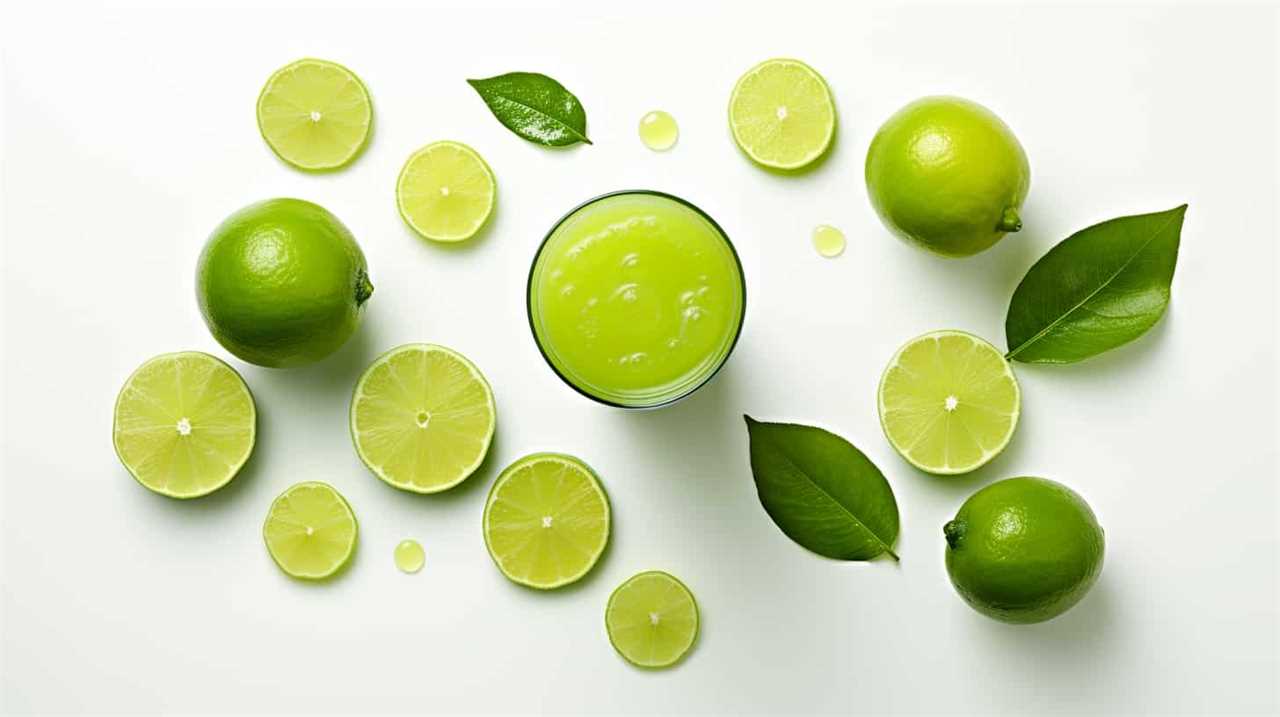
Key Takeaways
- Choose a reputable brand of aloe vera juice that prioritizes quality and uses organic, pure aloe vera.
- Avoid brands that contain added sugars or artificial ingredients.
- Use natural sweeteners like honey, agave syrup, or stevia to enhance the taste of aloe vera juice.
- Experiment with adding fruits, herbs, and other juices to create unique flavor combinations and enhance the health benefits of aloe vera juice.
Choosing the Right Aloe Vera Juice
We can enhance our experience with aloe vera juice by selecting the right brand and type for our preferences. When it comes to finding a reputable brand, it’s important to do some research and read reviews from other consumers. Look for brands that prioritize quality and use organic, pure aloe vera without any added sugars or artificial ingredients. Understanding the health benefits of aloe vera juice is also crucial in making the right choice. Aloe vera is known for its soothing properties, aiding digestion, promoting skin health, and boosting the immune system. By choosing a high-quality brand, we can ensure that we’re getting the maximum benefits from our aloe vera juice.
Now that we know how to choose the right brand, let’s move on to the next step of adding natural sweeteners.
Adding Natural Sweeteners
To enhance the flavor of our aloe vera juice, we can add natural sweeteners such as honey or agave syrup. Using alternative sweeteners not only adds sweetness but also brings unique flavors to the juice. Here are some options to consider:
- Stevia: A natural sweetener derived from the Stevia plant, it’s a zero-calorie alternative to sugar.
- Maple Syrup: This natural sweetener adds a rich and earthy flavor to the aloe vera juice.
- Dates: Pureed dates can be used to sweeten the juice while also providing essential nutrients like fiber.
In addition to using alternative sweeteners, we can enhance the flavor of aloe vera juice by adding spices and extracts. Cinnamon, ginger, or vanilla extract can add warmth and depth to the taste. By experimenting with different combinations of these natural sweeteners, spices, and extracts, we can create a flavor profile that suits our preferences.
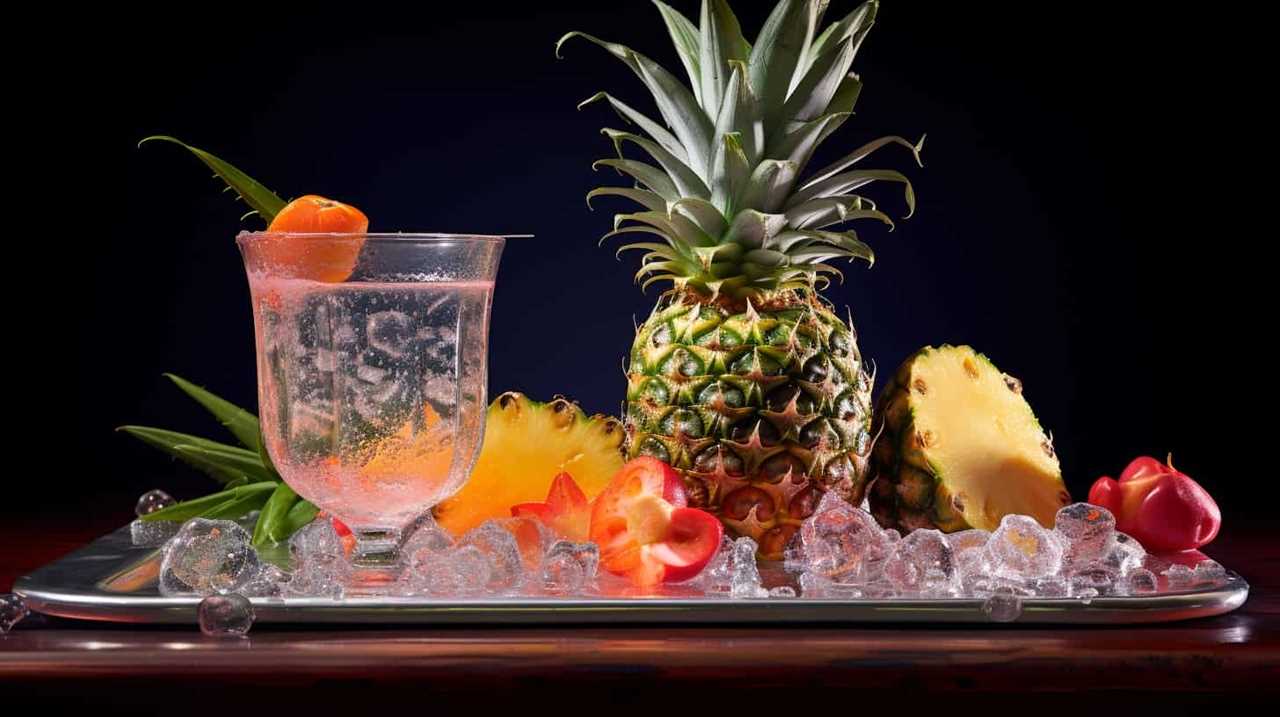
Now, let’s move on to the next section and learn how to infuse aloe vera juice with fruits and herbs to further enhance its taste.
Infusing With Fruits and Herbs
As we explore ways to make our aloe vera juice taste better, one option to consider is infusing it with fruits and herbs. Creating unique aloe vera blends by adding fruits and herbs not only enhances the flavor but also adds a touch of freshness and complexity to the juice. For example, combining aloe vera juice with lemon, mint, or berries can create a refreshing drink that’s both delicious and packed with additional nutrients. It’s similar to the ease of making lemonade with bottled juice—quick, convenient, and customizable to suit your preferences. By experimenting with different fruit and herb combinations, you can elevate your aloe vera juice experience while still reaping its health benefits.
Fruits like strawberries, pineapple, or citrus can add a burst of sweetness, while herbs like mint, basil, or ginger can provide a subtle yet refreshing twist. Exploring the benefits of herbal infusions can also be beneficial for our health. For example, adding a few sprigs of lavender can promote relaxation and reduce stress. Additionally, infusing aloe vera juice with rosemary can aid digestion and boost the immune system.
Blending With Other Juices
Let’s try mixing aloe vera juice with different fruit juices to create delicious and refreshing blends. Blending aloe vera juice with other fruits not only enhances its taste but also adds nutritional benefits to your drink. Here are three fruit juices that you can mix with aloe vera juice:

- Orange juice: Combining aloe vera juice with orange juice not only adds a tangy flavor but also boosts your intake of vitamin C, which is essential for a strong immune system.
- Pineapple juice: Mixing aloe vera juice with pineapple juice creates a tropical blend that isn’t only refreshing but also helps in digestion. Pineapple contains bromelain, an enzyme that aids in breaking down proteins and promoting better digestion.
- Watermelon juice: Blending aloe vera juice with watermelon juice creates a hydrating and refreshing combination. Watermelon is rich in water content and contains electrolytes that can help replenish your body’s fluids.
Experimenting With Flavor Combinations
While we can try various flavor combinations with aloe vera juice, it’s important to find the right balance to enhance its taste. Experimenting with different flavors can’t only make the juice more enjoyable but also enhance its health benefits.
Aloe vera juice is known for its numerous health benefits, such as boosting digestion, promoting hydration, and supporting the immune system. By adding complementary flavors, we can create a refreshing summer drink that not only tastes great but also provides a nutritional boost.
Some popular flavor combinations include mixing aloe vera juice with citrus fruits like lemon or orange, adding a splash of coconut water for a tropical twist, or combining it with cucumber and mint for a refreshing and cooling effect.
Don’t be afraid to get creative and find the flavor combination that suits your taste buds best!
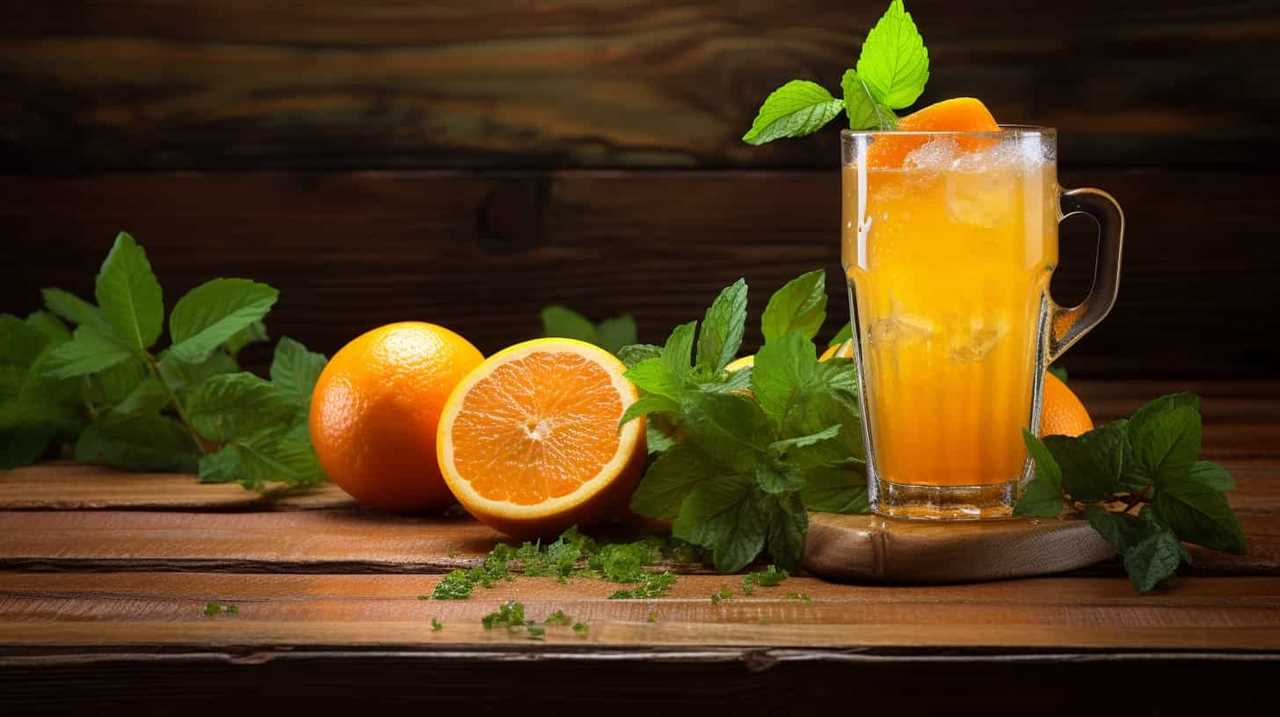
Frequently Asked Questions
Can I Use Store-Bought Aloe Vera Gel Instead of Fresh Aloe Vera for Making Juice?
Yes, you can use store-bought aloe vera gel instead of fresh aloe vera for making juice. However, it’s important to note that fresh aloe vera juice may have more health benefits due to its higher nutrient content.
How Long Can I Store Aloe Vera Juice in the Refrigerator?
Aloe vera juice can be stored in the refrigerator for up to a week. Refrigeration helps maintain the longevity and freshness of the juice, preserving its beneficial properties. It’s important to store the juice in an airtight container to prevent contamination and maintain its quality. Similarly, you might wonder *how long ginger juice lasts*; typically, fresh ginger juice can be refrigerated for about 1–2 weeks as well. Both aloe vera and ginger juices are best consumed within their shelf life to ensure maximum potency and health benefits. Additionally, freezing either juice can extend their shelf life, though some loss of nutrients and potency may occur during the process. When thinking about *how long fresh juice lasts*, it’s crucial to check for signs of spoilage, such as changes in smell, taste, or color, before consuming. To enjoy the best results, it’s always recommended to use fresh ingredients and properly store the juice to ensure you’re getting the most out of its health benefits.
Can Aloe Vera Juice Help With Digestive Issues?
Aloe vera juice can potentially help with digestive issues when taken in appropriate dosages. However, it is important to note that there may be potential side effects. It is always best to consult with a healthcare professional before starting any new supplement regimen.
Can I Use Artificial Sweeteners Instead of Natural Sweeteners in My Aloe Vera Juice?
Using artificial sweeteners in aloe vera juice may affect its taste and potential health benefits. However, natural sweeteners like honey or stevia can enhance the flavor without compromising its nutritional value.

Is It Safe to Drink Aloe Vera Juice Every Day?
Drinking aloe vera juice daily can have numerous benefits, such as improving digestion and boosting the immune system. However, consuming it regularly may also lead to potential side effects like diarrhea or stomach cramps.
Conclusion
In conclusion, making aloe vera juice taste better is easy and enjoyable.
By choosing the right aloe vera juice and adding natural sweeteners, infusing with fruits and herbs, blending with other juices, and experimenting with flavor combinations, you can create a delightful and refreshing drink.
So go ahead and unleash your creativity in the kitchen, and transform your aloe vera juice into a sensational elixir that will transport your taste buds to paradise.
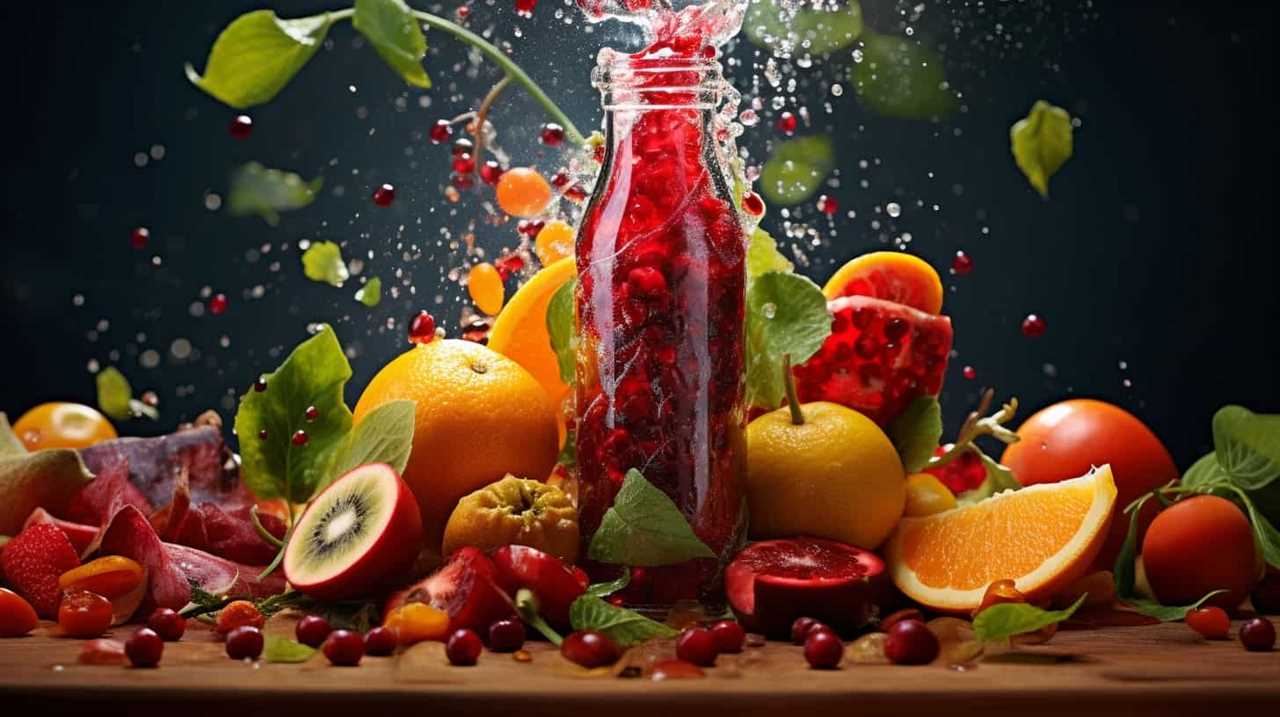
Susannah expertise lies in researching and compiling evidence-based content on juicing, nutrition, and overall health. She is committed to ensuring that The Juicery World offers accurate, up-to-date, and trustworthy information to empower readers to take control of their health. Susannah’s goal is to inspire individuals to embrace juicing as a way to nourish their bodies and live their best lives.
Juice Tips and Tricks
How to Make a Glass of Lemonade With Bottled Lemon Juice

Are you craving a cool glass of lemonade to quench your thirst? Look no further! Try out our perfect recipe using bottled lemon juice that will surely please your taste buds.
In this article, we’ll guide you through the process of creating a tangy and sweet concoction that will leave you feeling refreshed and satisfied.
So grab your ingredients and let’s get started on this delightful journey of serving ourselves and others a glass of pure lemony goodness.
Key Takeaways
- Consider the storage of the bottled lemon juice (dark glass or plastic bottles, protect from light exposure, check expiration date)
- Choose a suitable pitcher and fresh lemons for enhanced flavor
- Store the lemonade concentrate in the refrigerator to maintain freshness
- Adjust the sweetness and tartness to taste with sugar or more lemon juice, and experiment with different sweeteners or additional flavors.
Choosing the Right Bottled Lemon Juice
What are the key factors we should consider when selecting the right bottled lemon juice for our lemonade?

One important factor is how the lemon juice is stored. Look for bottles that are made of dark glass or plastic, as they help protect the juice from light exposure, which can degrade its quality. It’s also important to check the expiration date to ensure freshness.
Another benefit of using bottled lemon juice is convenience. It saves time and effort compared to squeezing fresh lemons. Additionally, bottled lemon juice provides consistent flavor, as the acidity levels are standardized.
When selecting a brand, consider reading reviews and checking for certifications, such as organic or non-GMO.
Gathering the Necessary Ingredients and Tools
How can we gather all the necessary ingredients and tools to make a glass of lemonade with bottled lemon juice? First, we’ll need to collect bottled lemon juice, sugar, and cold water, as well as a pitcher and a spoon for mixing. If you prefer extra flavor, you can also gather ice and optional add-ins like mint or soda water. While preparing the lemonade, it’s easy to understand why some people wonder about other citrus drinks and may ask, “how many oranges per gallon” are needed when making orange juice instead. Once everything is assembled, combine the lemon juice, sugar, and water in the pitcher, stirring until the sugar dissolves. Feel free to adjust the sweetness or tartness to your liking, and don’t forget to add ice or any optional add-ins for an extra refreshing touch. This process might even make you curious about how much juice from oranges is needed when making fresh orange juice compared to using bottled citrus products. Once your lemonade is ready, pour it into a glass and enjoy the refreshing taste. This simple recipe can inspire you to try other homemade juices, such as learning **how to make pear juice** or experimenting with other fruit combinations. Whether you’re using fresh fruits or bottled options, creating your own beverages is a fun and rewarding way to personalize your drinks.
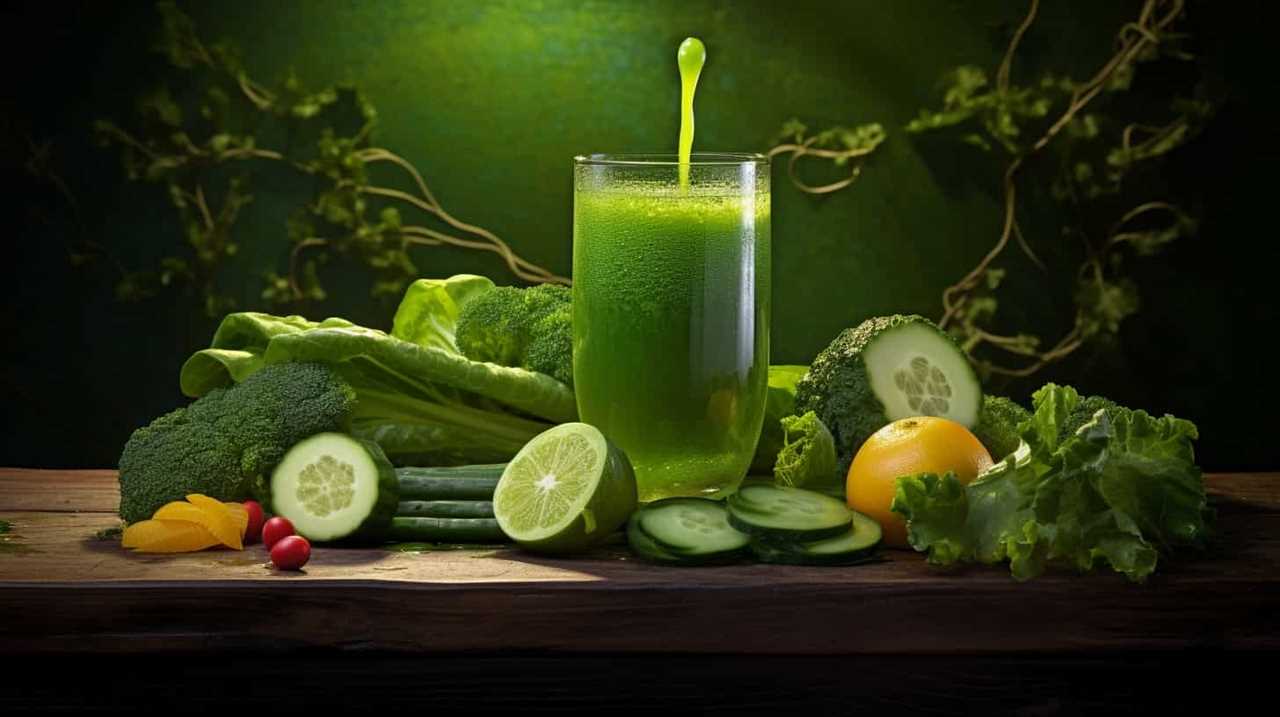
It’s important to start with the right pitcher. Look for a pitcher that’s made of glass or BPA-free plastic, as these materials won’t affect the taste of the lemonade. The pitcher should also have a lid or cover to keep the lemonade fresh and prevent spills.
Now, let’s talk about the lemons. While bottled lemon juice is convenient, using fresh lemons instead can elevate the flavor of your lemonade. Choose lemons that are firm and have a bright yellow color. Give them a gentle squeeze to ensure they’re juicy. To extract the juice, you’ll need a citrus juicer or a reamer. These tools make it easy to get every last drop of juice from the lemons.
Mixing the Lemonade Concentrate
To start mixing the lemonade concentrate, we’ll slowly pour the bottled lemon juice into the pitcher. It’s important to choose the right container for the lemonade concentrate. A pitcher with a lid or a tightly sealed container will help maintain the freshness and prevent any spills or leaks. Once the lemon juice is in the pitcher, we can move on to the next step of adding water and sweetener.
To ensure the lemonade concentrate stays fresh, it’s essential to store it properly. Keep the pitcher in the refrigerator to maintain its cool temperature and prevent any bacteria growth. If you have any leftover concentrate, transfer it to a smaller container with an airtight lid before refrigerating. This will help retain its flavor and prevent any contamination.

Now that we’ve mixed the lemonade concentrate, it’s time to adjust the sweetness and tartness to taste.
Adjusting the Sweetness and Tartness to Taste
We can adjust the sweetness and tartness of the lemonade to taste by adding more sugar or lemon juice, respectively. If you prefer a sweeter lemonade, simply add more sugar and stir until it dissolves completely. You can experiment with different sweeteners such as honey or agave syrup to find the perfect balance of sweetness.
On the other hand, if you want a tangier lemonade, add more lemon juice gradually, tasting as you go until it reaches your desired level of tartness.
Additionally, you can get creative with your lemonade by adding flavors like fresh mint leaves or a hint of lavender. These additions can elevate the flavor profile and create a more refreshing and unique experience.
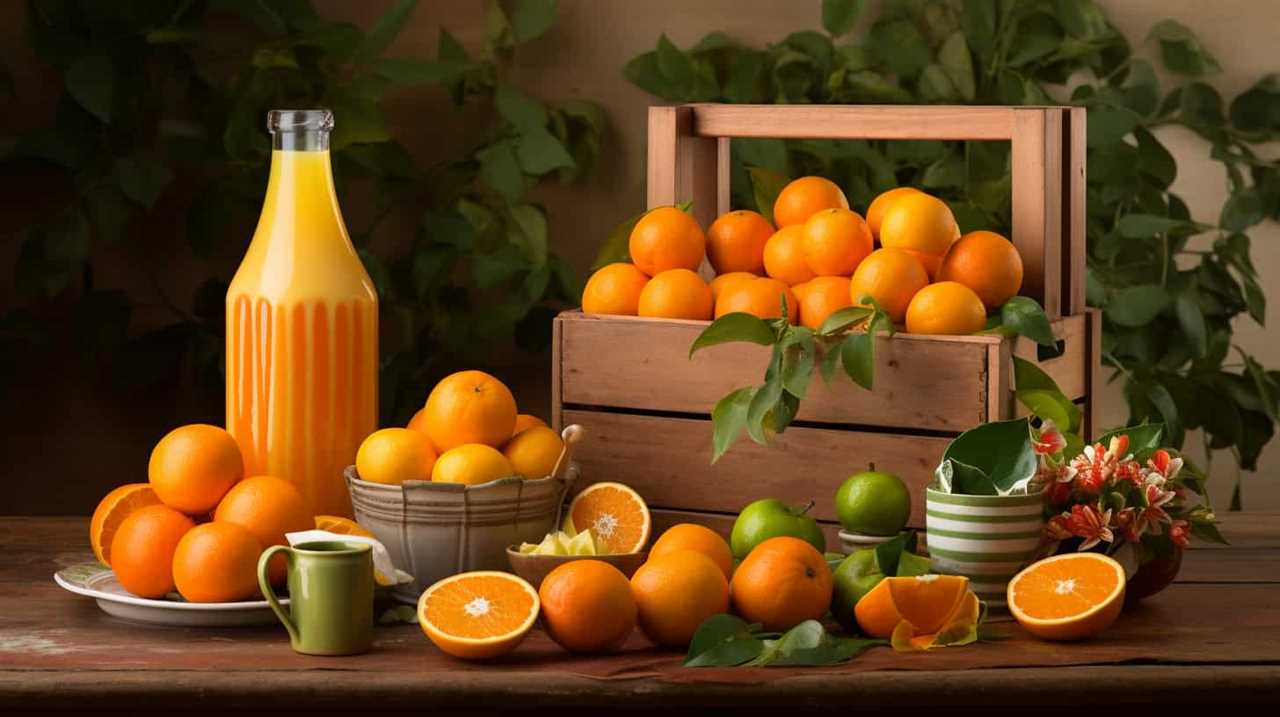
Now that we’ve adjusted the sweetness and tartness of our lemonade, let’s move on to serving and enjoying your refreshing glass of lemonade.
Serving and Enjoying Your Refreshing Glass of Lemonade
Now let’s sit back, relax, and savor our refreshing glass of lemonade.
When it comes to serving and enjoying this delightful drink, there are a few techniques and garnishing options to consider.
Firstly, serving your lemonade chilled is essential for maximum enjoyment. Ensure that you have chilled glasses or add ice cubes to the glasses before pouring the lemonade.

To add a touch of elegance, you can garnish your lemonade with a slice of lemon on the rim of the glass. For an extra burst of flavor, you could also add a sprig of fresh mint or a few berries.
Remember to gently stir the lemonade before serving to evenly distribute the flavors.
Now, take a sip, feel the refreshing tang of lemon, and let the sweet and tart flavors dance on your taste buds.
Cheers!
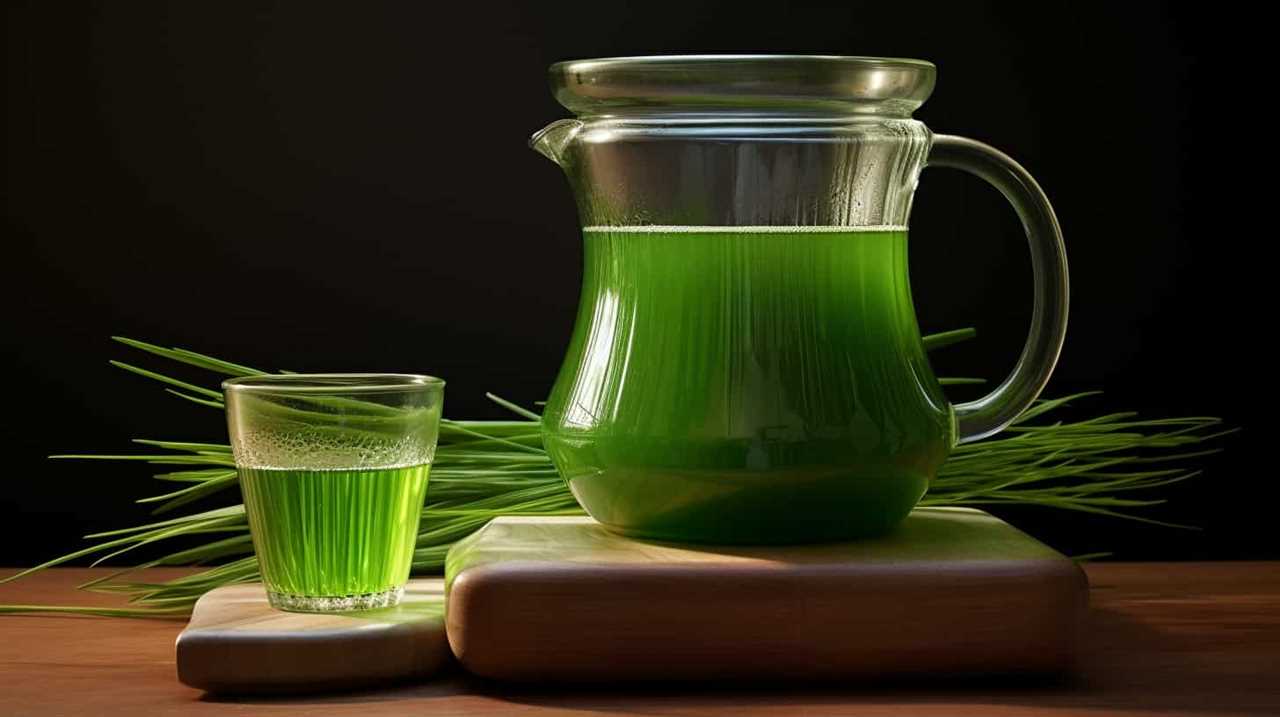
Frequently Asked Questions
Can I Use Fresh Lemons Instead of Bottled Lemon Juice?
Fresh lemons offer numerous benefits over bottled lemon juice. The taste of fresh lemons is unparalleled, providing a vibrant and tangy flavor. Incorporating fresh lemons into your lemonade will elevate its taste and give it a refreshing and authentic twist.
Can I Substitute Sugar With a Different Sweetener?
Substituting sweeteners in lemonade can enhance the flavor and offer health benefits. We’re knowledgeable about alternative sweeteners and can provide precise, detailed instructions on using them in place of sugar.
How Long Does the Lemonade Concentrate Need to Chill in the Refrigerator?
The chilling time for the lemonade concentrate in the refrigerator is typically around 1-2 hours. Using bottled lemon juice offers the benefit of convenience and consistent flavor for a refreshing glass of lemonade.
Can I Add Other Fruits or Flavors to the Lemonade?
Sure, we can definitely add different fruits or flavors to our lemonade. It’s a great way to experiment with unique flavors and create refreshing, personalized drinks. The possibilities are endless!

How Long Does the Lemonade Stay Fresh in the Refrigerator?
Lemonade made with bottled lemon juice can stay fresh in the refrigerator for about 5-7 days. To maximize shelf life, store it in an airtight container and keep it chilled.
Conclusion
And so, with a few simple steps and the right ingredients, a glass of refreshing lemonade is born.
Like a symphony of flavors dancing on your taste buds, this tangy elixir quenches thirst and brings joy on a hot summer day.
Just a sip transports you to a world of citrusy delight, where the sweetness and tartness blend harmoniously.

So go ahead, indulge in the art of lemonade-making and savor every drop of this sun-kissed nectar.
Cheers to the perfect glass of lemonade!
Susannah expertise lies in researching and compiling evidence-based content on juicing, nutrition, and overall health. She is committed to ensuring that The Juicery World offers accurate, up-to-date, and trustworthy information to empower readers to take control of their health. Susannah’s goal is to inspire individuals to embrace juicing as a way to nourish their bodies and live their best lives.
Juice Tips and Tricks
How to Know if Orange Juice Is Bad

We’ve all been in that situation before – reaching for a glass of orange juice and hesitating, unsure if it’s still okay to drink. Fear not! This article will give you the knowledge you need to determine for sure if your orange juice is still fresh or if it’s gone bad.
With a blend of scientific precision and practical tips, we’ll explore color changes, strange smells, off taste, texture changes, and mold or growth that may indicate spoilage.
Let’s dive in and serve ourselves a refreshing glass of certainty!
Key Takeaways
- Color changes in orange juice can indicate a loss of freshness and shelf life extension, but it doesn’t necessarily mean the juice is bad.
- Unusual or off-putting odors in orange juice, such as sour or fermented scents, can be a sign of poor quality.
- An off taste in orange juice, such as sour, bitter, or fermented flavors, suggests that the juice is spoiled.
- Texture changes in orange juice, such as pulp separation or a thicker consistency, can occur as the juice ages, so it’s important to consume it before the expiration date.
Color Changes in Orange Juice
We should be aware that color changes can indicate whether orange juice is bad.

When it comes to orange juice, color is a crucial factor to consider. As oranges are exposed to air, an oxidation process occurs, which leads to changes in color. Fresh orange juice has a vibrant orange hue, indicating its freshness and high nutritional value.
However, as time passes, the juice may undergo a color change, turning dull or brownish. This change in color is a result of the oxidation process, which affects the flavor and quality of the juice. It’s important to note that while a change in color doesn’t necessarily mean the juice is bad, it does indicate that the juice is losing its freshness and shelf life extension.
Therefore, it’s advisable to consume orange juice when it’s at its freshest, as indicated by its vibrant orange color.
Strange Smells in Orange Juice
When it comes to evaluating orange juice, we should be cautious of any strange smells or odors. A fresh, pleasant smell is indicative of good quality orange juice. However, if you notice any unusual or off-putting odors, it may be a sign that the juice has gone bad. These smells can range from a sour or fermented scent to a rancid or moldy aroma.
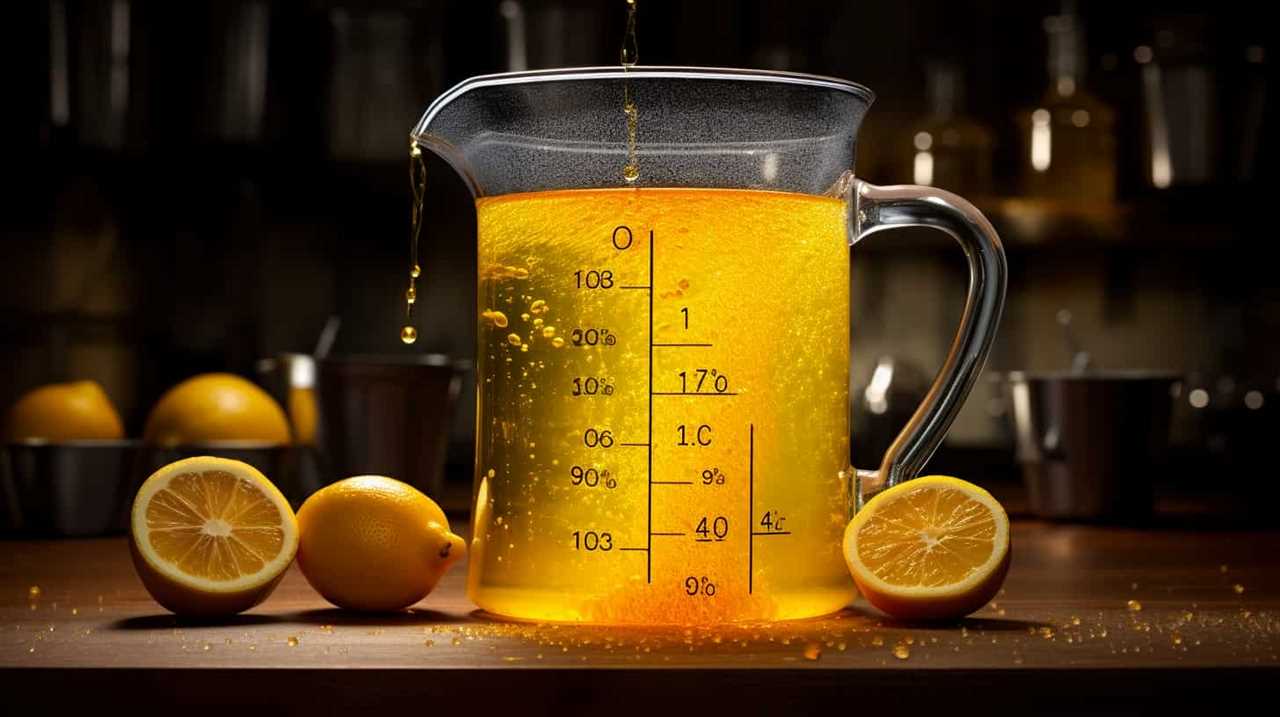
It’s important to note that while some natural variations in scent can occur due to the specific variety of oranges used, any strong or unpleasant smells should raise concerns. If you have citrus fruit allergies, it’s especially important to pay attention to the smell of orange juice, as it could indicate the presence of spoilage or contamination.
Ensuring the quality of orange juice is essential as it’s a popular beverage known for its health benefits, including being rich in vitamin C and antioxidants.
Off Taste of Orange Juice
Our taste buds can detect even the slightest hint of an off taste in orange juice, which can indicate that it has gone bad. The taste of orange juice should be fresh, tangy, and slightly sweet. If it tastes sour, bitter, or fermented, it’s likely spoiled.
One common cause of an off taste in orange juice is the use of overripe oranges. When oranges become overripe, their flavor profile changes, resulting in a less pleasant taste. Another factor to consider is the expiration date. Orange juice that has passed its expiration date is more likely to develop an off taste. It’s important to check the expiration date before consuming orange juice to ensure its freshness and quality. Additionally, improper storage conditions, such as leaving the juice at room temperature for extended periods, can lead to the development of unpleasant flavors. Storing orange juice in the refrigerator helps maintain its freshness for longer. For those exploring different juice options, aloe vera juice flavor tips suggest pairing tart juices with milder flavors to balance the overall taste.
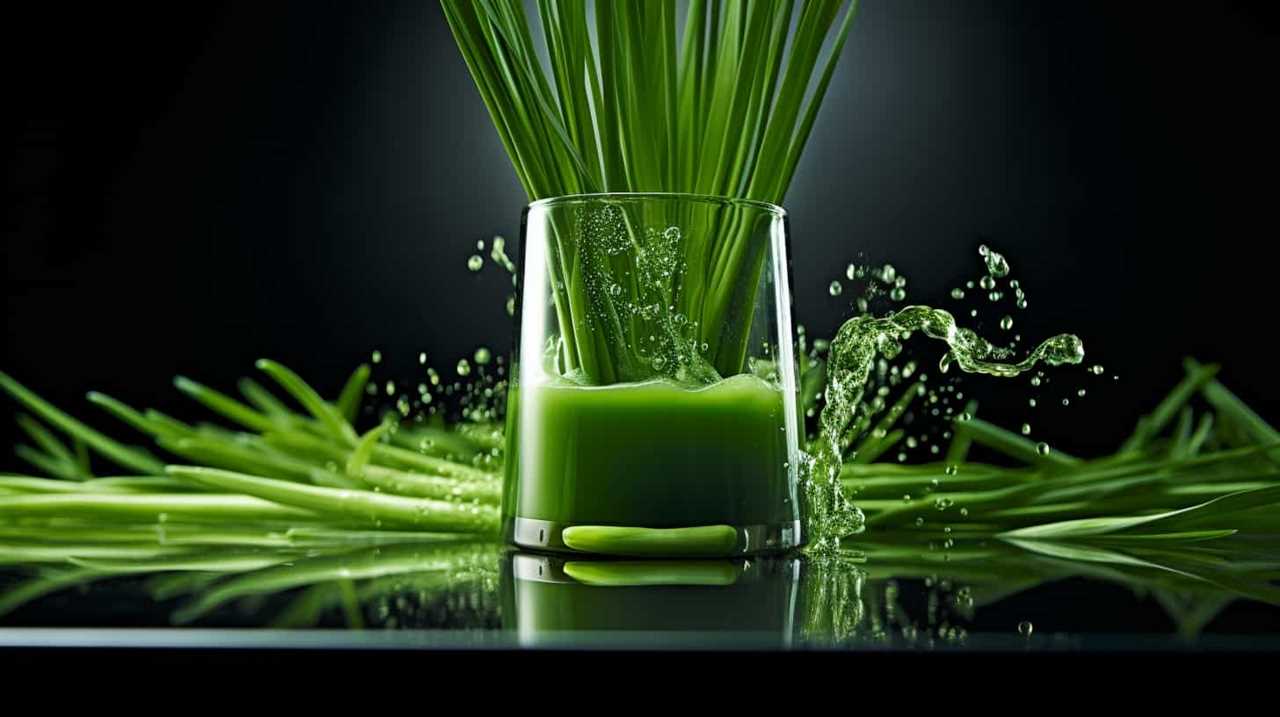
Now, let’s move on to discuss the texture changes in orange juice.
Texture Changes in Orange Juice
As we explore the texture changes in orange juice, it’s important to note that certain factors can cause it to become thicker or develop sediment. One common texture change in orange juice is pulp separation, where the pulp separates from the liquid and settles at the bottom. This can occur naturally over time, as the pulp particles become denser and sink.
Another factor that can affect the texture of orange juice is the expiration date. As orange juice ages, it may start to develop a thicker consistency and even form sediment. This is a result of the natural breakdown of the juice’s components. Therefore, it’s crucial to check the expiration date on orange juice and consume it before it reaches its expiration date to avoid any undesirable texture changes.
Mold or Growth in Orange Juice
We need to be aware of the possibility of mold or other growth occurring in orange juice. Mold can develop in orange juice if it isn’t stored properly or if it has passed its expiration date.
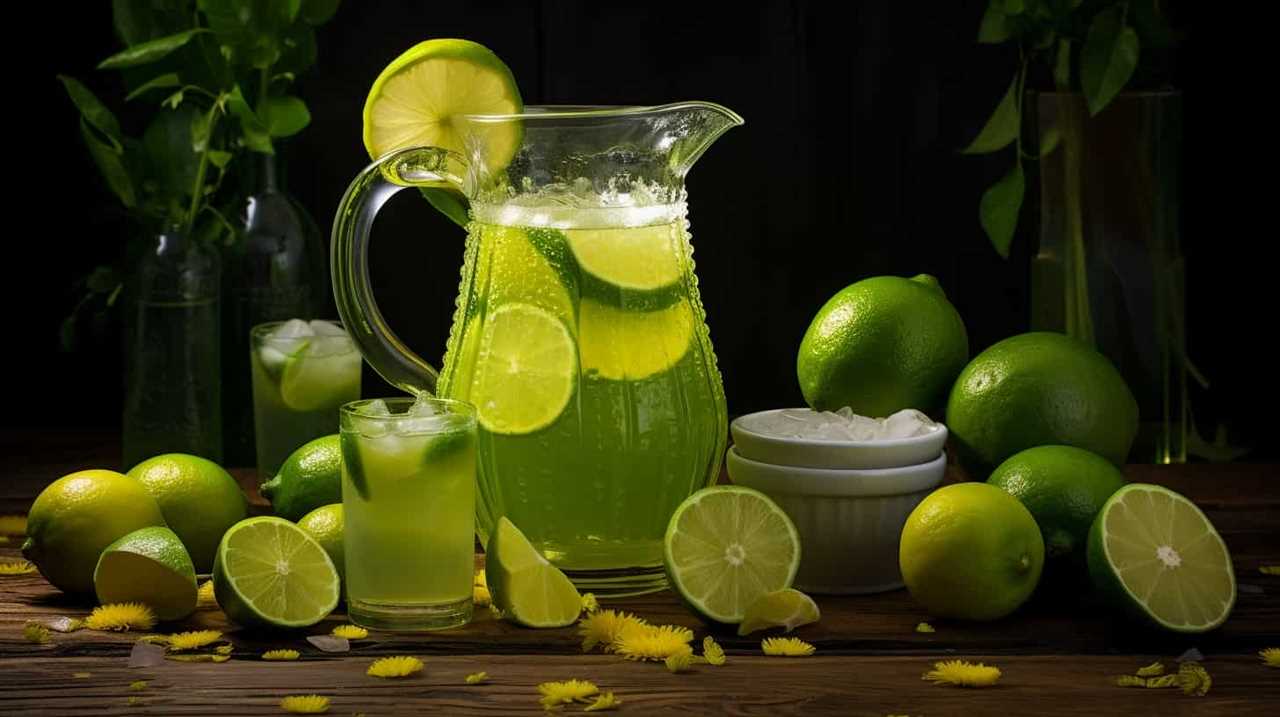
To prevent mold growth, it’s important to follow these steps:
- Store orange juice in the refrigerator at a temperature below 40°F (4°C).
- Check the expiration date on the bottle before consuming. Discard any orange juice that has expired.
- Keep the container tightly sealed to prevent air and moisture from entering, as these can promote mold growth.
Regularly inspecting orange juice for any signs of mold or unusual growth is essential. If you notice any discoloration, a strange odor, or visible mold, it’s best to discard the juice to avoid any potential health risks.
Frequently Asked Questions
Can Orange Juice Go Bad if It’s Stored in the Freezer for Too Long?
Frozen orange juice can potentially lose its nutrients and change its taste if stored in the freezer for too long. It is important to check for signs of spoilage before consuming it.
How Long Can Orange Juice Stay Fresh in the Refrigerator Once It’s Opened?
Once opened, orange juice can stay fresh in the refrigerator for about 7-10 days. To maintain its freshness, store it properly by keeping it tightly sealed and at a consistently cold temperature. If the orange juice develops an off odor, flavor, or appearance, it’s best to discard it to avoid any potential health risks. Factors like exposure to air and varying temperatures can influence how long orange juice lasts, so it’s crucial to handle it with care. Always check the expiration date as a general guide, but remember that proper storage can extend its freshness slightly. Additionally, avoid leaving the orange juice out at room temperature for extended periods, as this can significantly shorten how long orange juice lasts. Freezing the juice can be another option to extend its shelf life, but be aware that this may alter its texture and taste once thawed. By following these precautions, you can ensure your orange juice stays fresh and safe to consume.
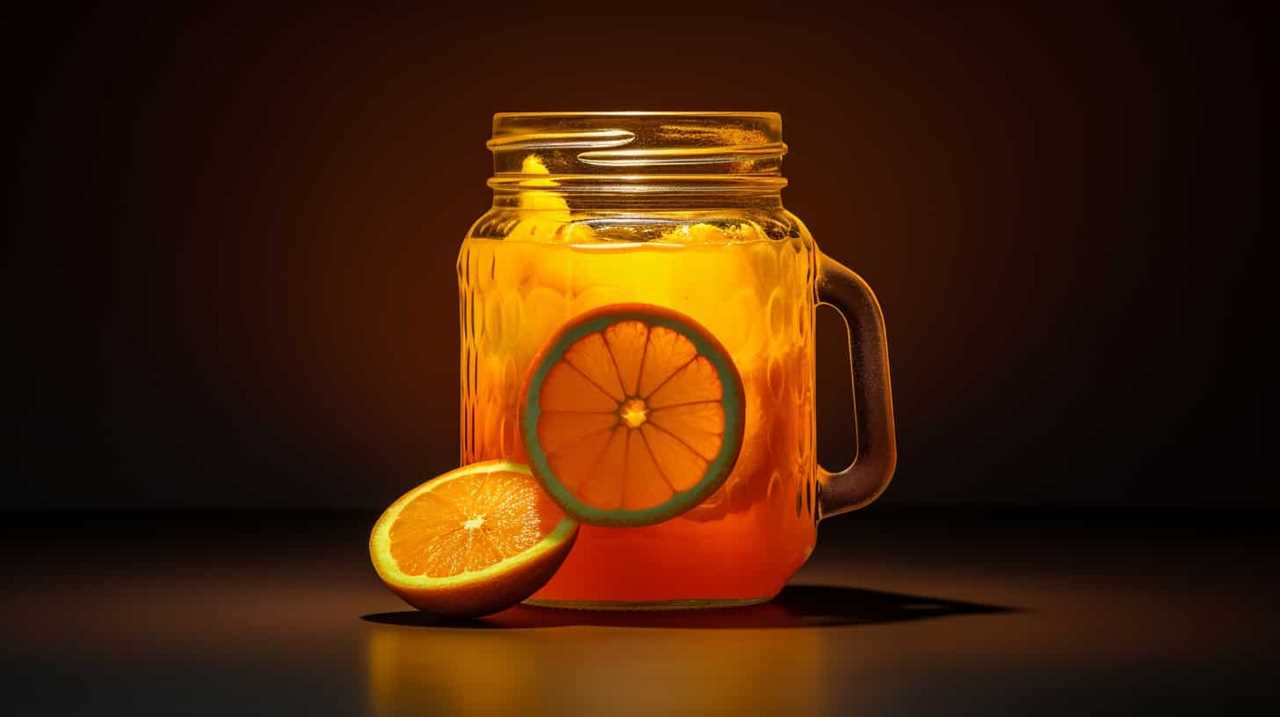
Is It Safe to Consume Orange Juice That Has Been Left Out at Room Temperature Overnight?
Left out orange juice may not be safe to drink as it can harbor harmful bacteria. Signs of spoiled orange juice include a sour smell, mold growth, and a change in color or taste.
Can Orange Juice Develop Harmful Bacteria if It’s Past Its Expiration Date but Still Looks and Smells Fine?
Orange juice can cause food poisoning if it develops harmful bacteria, even if it looks and smells fine. Signs of spoiled orange juice include a sour smell, mold growth, and a change in color or taste.
Does the Nutritional Value of Orange Juice Decrease as It Starts to Go Bad?
As orange juice goes bad, its nutritional value decreases. The longer it sits on the shelf, the more nutrients it loses. Signs of spoilage include a sour smell, off taste, and mold growth.
Conclusion
In conclusion, determining if orange juice is bad requires careful observation of color changes, strange smells, off taste, and texture changes. Just like a detective investigating a case, we must rely on our senses to detect any signs of spoilage.
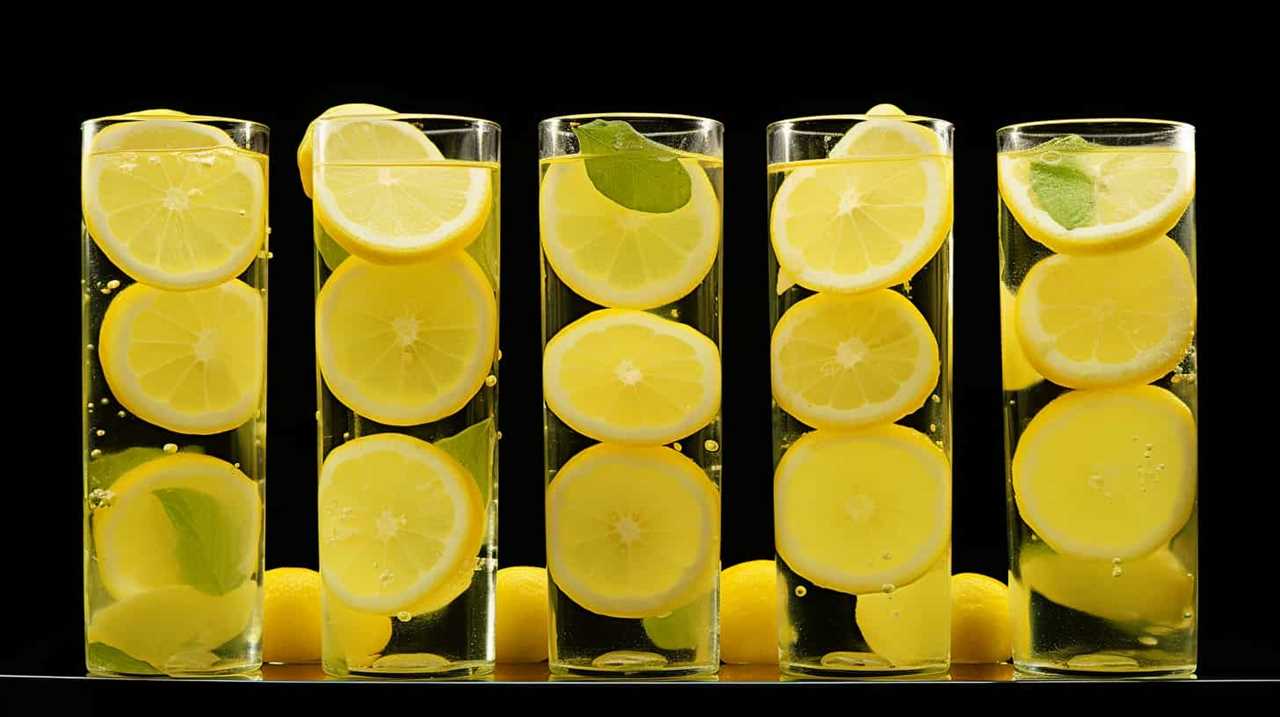
If we detect mold or growth in the orange juice, it’s a clear indication that it’s no longer safe to consume. By remaining vigilant and attuned to these indicators, we can ensure that our orange juice is always fresh and enjoyable.
Susannah expertise lies in researching and compiling evidence-based content on juicing, nutrition, and overall health. She is committed to ensuring that The Juicery World offers accurate, up-to-date, and trustworthy information to empower readers to take control of their health. Susannah’s goal is to inspire individuals to embrace juicing as a way to nourish their bodies and live their best lives.
-

 Vetted2 months ago
Vetted2 months ago15 Best Juices for Diabetics: Refreshing Options That Won’t Spike Your Blood Sugar
-

 Vetted2 months ago
Vetted2 months ago15 Best Decaf Coffee Options for Flavor Lovers Who Need a Caffeine Break
-

 Vetted2 months ago
Vetted2 months ago15 Best Espresso Ground Coffees to Elevate Your Morning Brew
-

 Vetted2 months ago
Vetted2 months ago15 Best K-Cup Coffee Pods for a Perfect Brew Every Time
-

 Vetted2 months ago
Vetted2 months ago15 Best Beans for Espresso: A Guide to Perfecting Your Brew
-

 Vetted2 months ago
Vetted2 months ago15 Best Inexpensive Espresso Machines That Brew Quality Coffee on a Budget
-

 Vetted2 months ago
Vetted2 months ago15 Best Cold Brew Coffees to Keep You Refreshed All Summer Long
-

 Vetted2 months ago
Vetted2 months ago15 Best Kona Coffees to Savor the Rich Flavors of Hawaii



